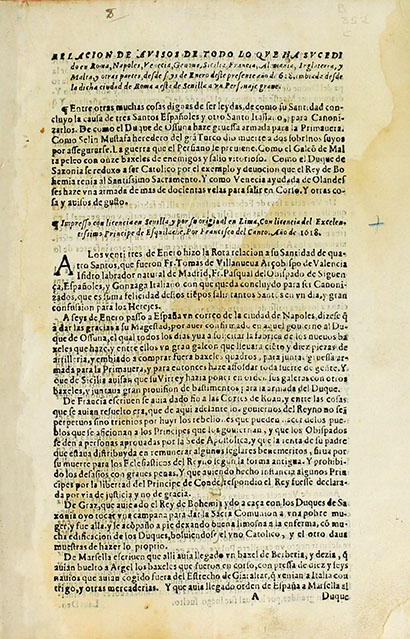
Libraries
Libraries
Relación de avisos de todo lo que ha sucedido en Roma, Nápoles, Venecia, Génova, Sicilia, Francia, Alemania, Inglaterra, y Malta
This loose form is an early sample of the exchange of information that constitutes the dawn of the transfer of information that, towards the end of the seventeenth century, would produce the first official newspapers of the continent. Here we read events that occurred in various parts of the European continent accompanied by an interpretation: “Entre muchas cosas dignas de ser leydas, de como su Santidad concluyó la causa de tres Santos Españoles y otro Santo Italiano o para canonizarlos. De como el Duque de Ossuna hace gruesa armada para la Primavera. Como Selin Mustafa heredero del gran Turco dio muerte a dos sobrinos suyos por asegurarse. La guerra que el persiano le previene. Como el galeón de Malta peleo con once baxeles de enemigos y salio victorioso. Como el Duque de Sajonia se redujo a ser Católico por el ejemplo y devoción que el Rey de Bohemia tenía al Santísimo Sacramento. Y como Venecia ayudada de Olandessa hace una armada de más de doscientas velas para salir en Corso. Y otras cosas y avisos de gusto”.
This document shows how the Kingdoms of Peru were aware of what happened in the cities of the Old World and, therefore, are part of the beginning of modern journalism. This document was printed the same year in Seville by Juan Serrano de Vargas and it did not take long for it to arrive at the Lima presses of Francisco del Canto. The news circulated under the designation of new, relations or notices. The habit of printing individual news led at the beginning of the 18th century to the publication of Diario de noticias sobresalientes en Lima together with Noticias de Europa (Lima, 1700 to 1711).
Jean Christian Egoavil
Proyecto Estudios Indianos

